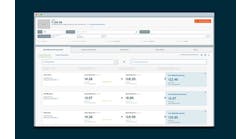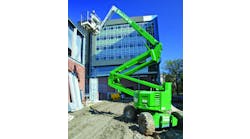By year's end, 2008 will un-doubtedly have made its mark in many ways, but it doesn't look like a stellar economy will be one of them. Rental companies are faced with an interesting decision: Demand remains strong for many types of rental products and equipment, but how much should an owner expand the inventory to capture more of that business? How do owners balance opportunity with caution when it comes to allocating their inventory dollars?
The clues for all future inventory decisions are in the data from past investments. The market for your rental service is not static; it fluctuates in response to construction and remodeling activity, population growth, business expansion, homebuilding, and any number of other trends in your local area. Rental computers are adept at capturing the data that identifies these trends — yet a surprising number of rental operators simply don't use the decision-making tools built into their software. Computers are powerful information banks but they are only tools, and must be used properly to arrive at solutions.
In the case of inventory allocations, the answers lie in making educated assumptions about whether one category of equipment is more likely to be rented than another, consistently over time. Sustainable ROI is at the heart of true inventory analysis. Most rental owners have seen extreme bursts of demand for a product due to factors such as seasonality or construction start-ups. Those spikes can skew an owner's perception about adding inventory because they are both memorable and profitable, but they have limited value in terms of inventory analysis unless they have sustainability.
To get a real handle on potential returns, you need to analyze your inventory's performance over time. A good rental inventory analysis report will show you revenue, maintenance expense, time utilization and return-on-investment information for the range of inventory you select: by item, by category and by department. In addition, you should be able to look at performance for the current month, the past 12 months, and each inventory item's life to date. Because many rental items have a seasonal demand, it's usually best to look at performance over at least 12 months. This is all familiar ground to rental operators who regularly use the inventory analysis features in their software.
Not quite so familiar is the concept of missed rentals. Almost all rental businesses try to maintain a sense of missed rentals as a measure of unmet demand. Oftentimes, this is empirical — the counter staff or owner has a “gut instinct” about losing rentals when demand for a product exceeds availability. Like the profit spikes mentioned earlier, these instances tend to stay in your mind and become larger than life. Instinct and empirical observation certainly serve a purpose in business, but their place is not in the inventory decision process. The dollars are too big and the potential missteps too costly.
Missed rentals, like any metric, return varying degrees of value based on the data-capture process. At its most simplistic level, the process should always leave as little subjectivity to humans as possible.
For example, it usually doesn't work well to have employees make manual notations of missed rentals, even if those notations are made in the computer system. This puts the burden on employees to decide whether a given incident is really a missed rental versus a price check, tire-kicking inquiry or competitor's fishing expedition.
Then there is the issue of inconsistency. If employees are busy, preoccupied or simply uninterested, they may record missed rentals information inconsistently or not at all. This severely limits the value of any analysis.
Completely new inventory categories are the obvious exceptions to the rule. Manual notations may be the only way to record information about items you don't currently stock. Missed rental trends for non-stocked items can be just as instructive as analysis of your existing inventory mix.
One robust form of missed rentals recording occurs when the software periodically scans your rental inventory categories to determine whether enough units are available to satisfy one additional, theoretical rental if it was requested of you. If not, the system makes its own notation and can report on the accumulated results. Essentially, the computer is posing a “what if” scenario.
In the computer world, this is an example of what is called predictive technology, and it has other applications within the rental industry; yield management, for example. The theoretical method of logging missed rentals is useful in that it's proactive — it flags rental categories that could need replenishing before you turn customers away, by analyzing the trends.
Cross-reference your data
If you work strictly with even the most robust rental inventory analysis report, you're missing some important information. You can add dimension to your decision-making by cross-referencing inventory analysis with missed-rentals reporting to capture the full picture.
For example, working from rental inventory analysis data (see illustration), you might conclude that it makes sense to add both a 185-cfm compressor and a 375-cfm compressor to your fleet. Both have a very high return on investment rate. But that doesn't necessarily indicate the earning power of additional units. You can limit your capital expenditure to one compressor model with the greatest chance of success by looking at the incidence of theoretical missed rentals over 12 months. If the 185-cfm unit and the 375-cfm unit show missed rentals of 11 and 54, respectively, invest in the 375-cfm compressor.
Another example of cross-referencing data is sub-rent activity. You may not show many missed rentals in a certain category because you have sub-rent arrangements in place to top off your own inventory. Sub-rent data presents another opportunity to analyze the financial expectations of investing additional capital in that category.
The concept of extracting value from capital expenditures transcends budget amounts. Even if you plan to spend far less this year than last, you'll want to put that capital where it's going to make you the most money. Fifteen or 20 years ago, rising demand had the ability to gloss over many inventory mistakes. Today that's no longer true. Look for high performance levels in at least three metrics — return on investment, missed rentals and time utilization — and you've given your hard-earned dollars the best chance to grow your business.
This year it's more important than ever that you make the right moves to both save money and make money as you evaluate your inventory against customer needs. Your data represents a reliable way to raise the confidence level of each investment you make.
Jack Shea is president of Springfield, Mass.-based Solutions by Computer.





